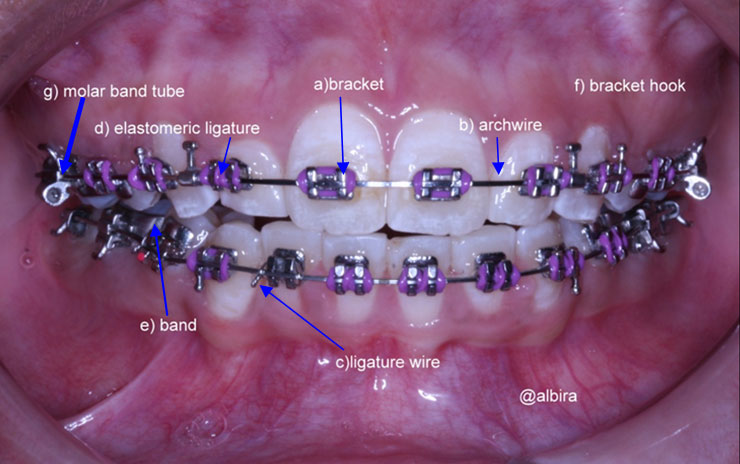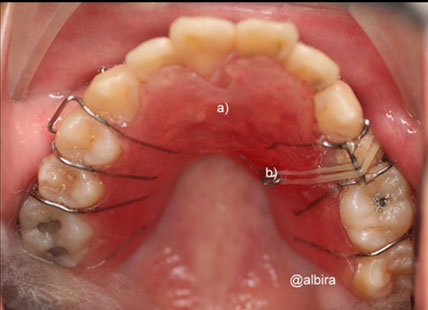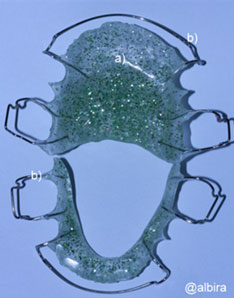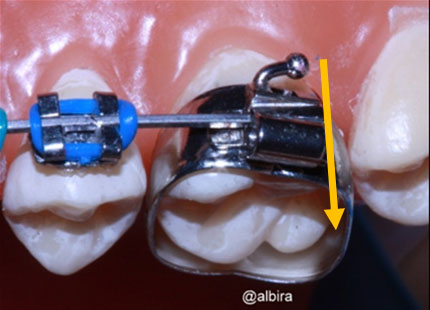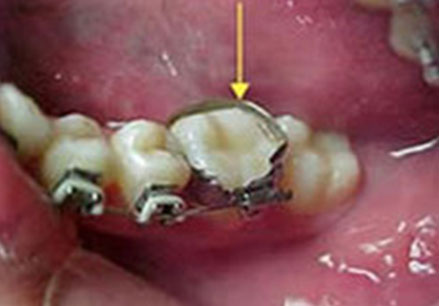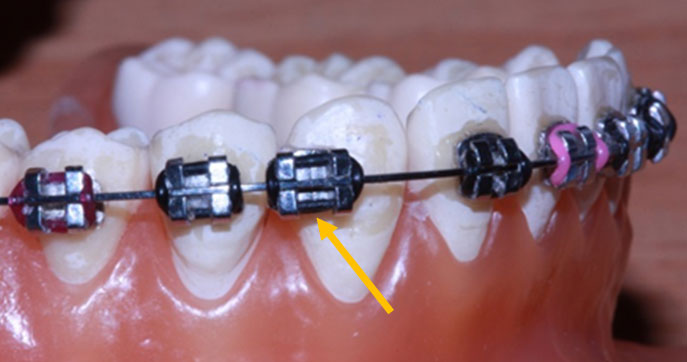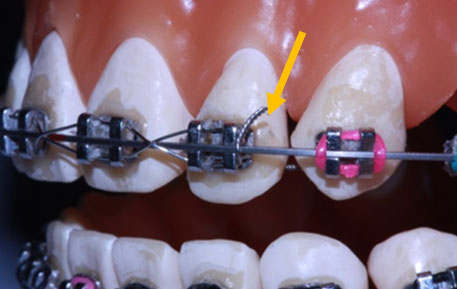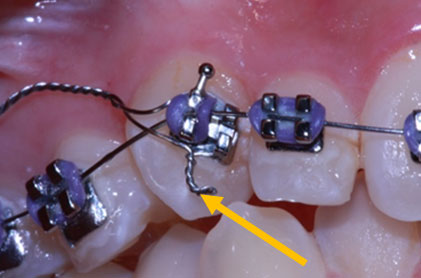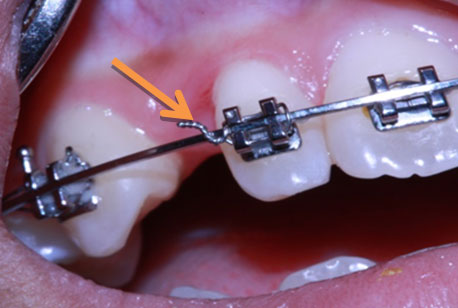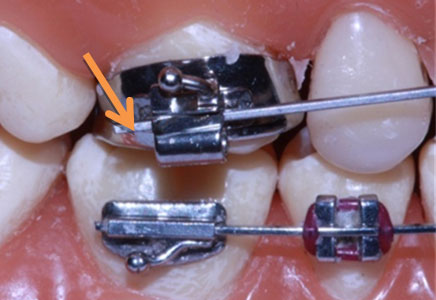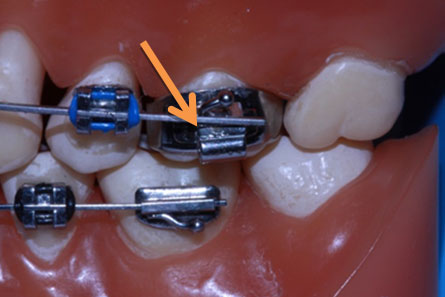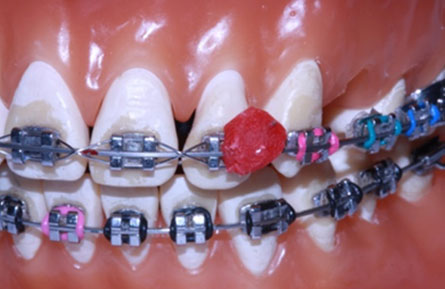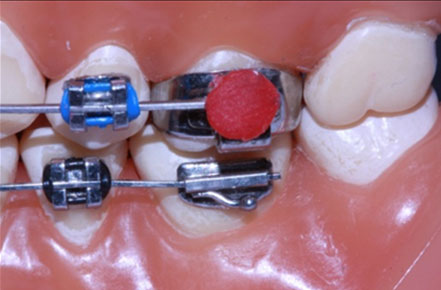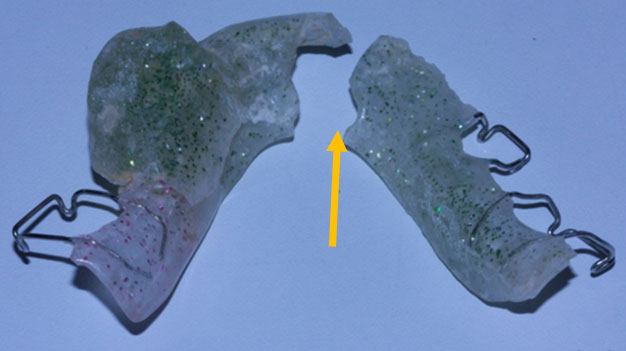Introduction
Misaligned teeth and an incorrect bite are the most popular reason why patient seek for orthodontic treatment and wear braces.
Braces:
Braces are devices used in orthodontics to align and straighten teeth and help to position them with regard to a person’s bite at the same time also working to improve dental health. Braces can be removable or fixed.
Get to know you braces main components:
Fixed braces:
The components of fixed braces would include :
- Bracket – Brackets are small metal squares that are attached or cemented temporarily to the teeth. The bracket has a small space horizontally through the middle, to allow the archwire to fit into it. Some brackets may have an extra attachment called a ball hook to allow for the use of other elastics or attachments. They may be made from nickel titanium, stainless steel, acrylic, ceramic, or gold.
- Archwire -This is a long continuous thin wires that guide your teeth to move into alignment. Archwire that commonly use are made of metal stainless steel and nickel titanium. It is being secured to the brackets with little rubber elastics or small thin metal ties.
- Elastomeric ligature tie – These are the small rubber rings (colored) that hold the archwires on each bracket.
- Metal ligature – small tiny wire usually to tie archwire to the bracket.
- Band – This is a metal ring that is placed around the tooth and is usually fitted on the back teeth. The band is cemented to the tooth with a special bonding agent.
Component of Removable braces:
- An acrylic baseplate (supports the wire components and helps provide anchorage
- Stainless steel Wire for construction of clasps (aid retention).
- Stainless steel Wire for active component
Emergencies in orthodontic
Occasionally, braces can cause pain and discomfort during treatment. This is a normal occurrence. It comes from many sources. Most commonly from tightening of the braces, small pokey wire, loose bands and brackets. Simple solution and tips at home might useful to solve the problem. But as a general rules, patient should contact the orthodontic clinic as soon as possible to get an appoinment to had it seen by orthodontist.
Loose band:
Orthodontic bands are the little stainless steel rings located on molars to hold the wire in place. Bands are secured to the tooth temporarily, with cement designed for orthodontic bands. Over time, various factors can cause the bands to become loose. Loose band usually can be due to eating hard food, eating sticky candy and has habit of chewing ice or other hard objects. Very often, the bond between the tooth and band is poor causing the band to become loose. It can delay your orthodontic treatment or accidentally choke on it or causing discomfort if it doesn’t get properly fixed.
Immediate solution : Call or informed your orthodontist. In the mean time, remove if it is too loose and can be taken out from the tooth. Otherwise press it in and use wax to hold it back in place until you can be seen by the orthodontist. Do not apply any rubberbands (elastics) or headgear on loose band if you are wearing.
Prevention : Try to avoid eating hard, crunchy and sticky food. Stop any bad habit such as bitting ice cube.
Loose brackets
A broken bracket can occur for several reasons including eating foods that are crunchy, sticky and very hard. Such foods are pizza crust and apples. Apples for example should be cut into small pieces. Habits such as fingernail biting or chewing on pen or pencil also can cause bracket off. You may know your bracket off if bracket can be slipped easily back and forth or if the bracket comes off the tooth.
Immediate solution: Most of the time it is not necessary to come to the clinic for immediate treatment. If your bracket is still attached to the wire, you can leave it in place and put wax to cover if it irritating. The area to place wax need to be dried with a tissue or clean cloth. If the bracket comes out entirely from the archwire, try to remove it with tweezer or grab it, wrap the bracket with a tissue and bring it to orthodontic clinic immediately or when you have time to visit orthodontic clinic as soon as possible. Do not connect any rubberbands to a loose bracket and do not place headgear facebow to loose bands.
Prevention: This may be avoided by eating only the appropriate foods.
Wire Poking:
|
|
|
Small thin wires (metal ligature) are usually used to tie the archwire to the brackets or bands. Sometimes, this tie can accidentally comes out during eating or brushing and cause irritation or discomfort to lips or cheeks. Archwire also can be pokey if ends overshoot or slip out from the tube during treatment. You should see signs for example, sharp archwire edges, ulcer on the cheek or lip, elevated wire or archwire ends slip out from the buccal tubes.
Immediate solution: Try to push the small and thin pokey wire back into place by using the end of a pencil eraser. You can also use tweezer to tuck it behind your bracket or under the main archwire for comfort . If the wire slip out of the tube of back tooth from the other side, use end pencil eraser to push it back. If wire slip out totally from band tube, try placing the wire back in the tube using tweezers. If a wire is loose, you may clip it using clean nail clippers. You may use gauze, cotton, tweezers or a tissue to hold the free end of the wire for easy removal after clipping. If that is not possible, you can pinch a small wax and place on the area causing the irritation until you can be seen by your orthodontist.. Sugarless chewing gum also useful as an alternative to orthodontic wax. In the meantime, you may rinse your mouth with warm saline water.
Broken appliance
Broken appliance is also a common occurrence among wearers of removable braces. This might happen if patient accidentally drop it on the hard surfaces or forcing ill fitting removable braces. Broken braces can present as broken pieces, chipped acrylic base or broken wire components. The metal or acrylic parts of removable appliances may break or bent. It can cause some complication such as ulcer, pain, discomfort, gum swelling due to loose wire impinging, sharp edges and ill fitting due to distortion. The worst scenario that can happen is to accidentally swallow it!
Immediate solution: Do not wear broken appliance if it loose. Call the orthodontic clinic and make an appoinment for repair as soon as possible.
Prevention: Be careful not to drop it usually during cleaning. Do not wrap it with tissue whenever you need to take it out. Always use a retainer box to keep the retainer safe.
Conclusion
The orthodontist or dental officer usually will see orthodontic emergency patient as soon as possible. It is very important for patient to inform or call orthodontic clinic for instructions and appoinment. The sooner the braces problems fixed, the shorter time it will take for orthodontic treatment to be completed. For patient’s convenience, verbal or written information regarding how patient can address simple common orthodontic issues should be provided. Remember, it is very important to report any loose brackets or loose bands to your orthodontist as soon as possible. Know what you can and need to avoid during eating if you are wearing braces!
References
1. American Association of Orthodontist. Handling orthodontic emergencies.
2. Avesh S & Chaturvedi TP (2011).A new protocol for emegency orthodontic care. The orthodontic CYBERjournal.
3. The American Dental Association – Oral Health Topics. “Braces and Orthodontics”.
| Last Reviewed | : | 28 August 2020 |
| Writer | : | Dr. Albira Sintian |
| Accreditor / Reviewer | : | Dr. Hjh. Rashidah bt. Dato’ Hj. Burhanudin |


